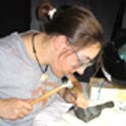Potential New Dinosaur Species from British Columbia
Potential New Dinosaur Discovered in British Columbia
Most people imagine that new species of dinosaur are discovered in some remote, desolate part of the world. Indeed, this is often the case, excavations in the outback of Australia, up mountains in Antarctica and the deserts of China have all yielded evidence of dinosaurs new to science. Sometimes a new, as yet undescribed dinosaur can be literally under the noses of the scientists, yet can go unnoticed.
A previously unknown dinosaur may have been discovered after a set of fossilised bones in storage at the Royal British Columbia Museum were re-examined by a group of palaeontologists.
The group of just seven bones, believed to represent a single individual were discovered in northern British Columbia in 1971, but they have only recently been studied in detail and the conclusion drawn is that these bones represent an unknown species.
The fossils were found by geologist Kenny Flyborg Larsen, searching for uranium deposits near the confluence of Birdflat Creek and the Sustut river, north-east of the small town of Terrace in British Columbia. An area more associated with fine fishing than with dinosaur discoveries. The partial skeleton is believed to be approximately 70 million years old (Maastrichtian faunal stage of the Late Cretaceous), although more precise dating cannot be made as no record of the exact location of the discovery exists so the sediments in which they were deposited are not known.
Larsen kept the fossils until 2004, deciding to donate them to Dalhousie University’s Earth Sciences department. The fossils were moved to the Royal British Columbia Museum in 2006. This gave University of Alberta palaeontologist Victoria Arbour and her co-author of the paper on these fossilised bones, Milton Graves, a scientist from Dalhousie University the chance to study them. The authors conclude in their findings published in the latest edition of the Canadian Journal of Earth Sciences, that these bones belonged to as yet undescribed bird-hipped dinosaur, an ornithischian dinosaur.
Commenting on her research, Victoria stated:
“There are similarities with two other kinds of dinosaurs, although there’s also an arm bone we’ve never seen before. The Sustut dinosaur may be a new species, but we won’t know for sure until more fossils can be found. It’s very distinct from other dinosaurs that were found at the same time in southern Alberta.”
University of Alberta Palaeontologist Victoria Arbour Prepares the Fossils

Picture credit: University of Alberta Handout
She hopes to lead an expedition to the discovery site in search of more evidence.
Other dinosaur finds have been made in British Columbia. in the past three decades, but the area is not as famous for Late Cretaceous dinosaurs as the neighbouring state of Alberta. However, there may be many more exciting dinosaurs awaiting discovery in the rugged country of British Columbia. A number of trace fossils (footprints) of dinosaurs have been discovered at a number of sites in the state but the the belated documenting of the 1971 find could make these fossil bones the first dinosaur body fossil ever discovered in British Columbia, the authors note.
In a statement released by the University of Alberta, the seven bones consisting of leg material, arm, toe and possible skull bones resemble bones from a small, bipedal, herbivore. For the moment, these remains have been classified as ornithischian, the same Order as the horned dinosaurs such as Torosaurus and Triceratops and the hadrosaurs such as Edmontosaurus.
Safari Ltd have a variety of ornithischian dinosaur models in their range: Wild Safari Prehistoric World Models.
The researchers have tentatively named this British Columbian dinosaur Cerapoda incertae sedis, a nomen nudum, as the authors comment that the name may be altered “pending the discovery of additional diagnostic material.”
A nomen nudum is a name given to an organism by scientists that has not yet formally been described and for which no holotype (a specimen upon which the first description of the organism is based), has been formerly designated.
So new species of dinosaur can come to light when examining the fossils already found and stored within museums and other institutions. The British Columbia case is not unusual, a number of new exciting discoveries have been made when fossils have been re-examined. For example, the discovery of a new type of long-necked dinosaur (Sauropod) when fossil vertebrae were studied in detail at the Natural History Museum in London.
To read about the London discovery: Where is the best place to find a new Dinosaur? In a museum collection!

